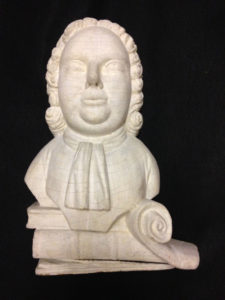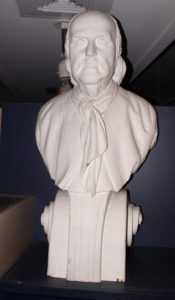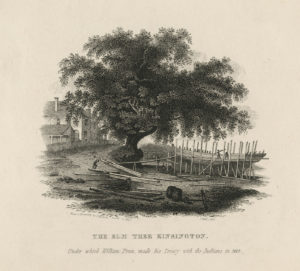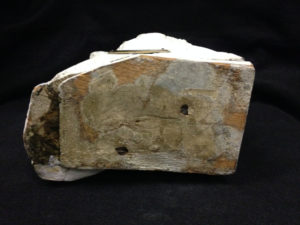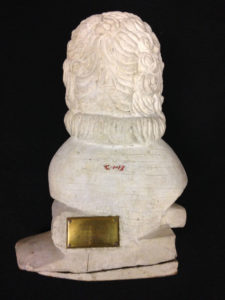“The limb in my Fathers arms:” The Environmental and Material Creation of a Treaty Elm Relic

In 1876, during city-wide celebrations of the nation’s centennial, Philadelphia architect and carpenter William Eyre reminisced upon an unusual family heirloom: a carved portrait bust of William Penn, now at the Philadelphia History Museum (fig. 1). Standing twelve inches high, the bust depicts the rotund proprietor of the Pennsylvania colony sporting a tightly curled wig and cravat. The figure’s midsection rests upon a stack of books, papers, and a scroll unrolling to the lower right and his carved eyes gaze upward to the heavens. Thick layers of white paint, now traversed by a web of fine cracks, cover the surface of the sculpture. During the centennial, the bust was displayed “as an Ancient Relic” in Carpenters’ Hall, which hosted the First Continental Congress in 1774. In his diary, Eyre, then president of the Carpenters’ Company, which owned and maintained Carpenters’ Hall, recalled that the bust was made from the wood of the Treaty Elm, under which it was believed Penn made a peaceful agreement with the Lenape Indians in 1682 or 1683. Benjamin West’s widely reproduced painting, Penn’s Treaty with the Indians (fig. 2), commissioned in late 1770 or early 1771 by Thomas Penn as a tribute to his late father, provided a visual narrative for this enigmatic event. While scholars still debate the treaty’s location, date, and content, history does record the expiration of the cherished Treaty Elm, which stood on the banks of the Delaware River in the Kensington neighborhood of Philadelphia: It fell down in a storm on March 3, 1810. Newspapers from Vermont to South Carolina reported the ancient tree’s demise: “This celebrated tree, having stood the blast of more than a century since that memorable event, is at length prostrated to the dust!”
Following its fall, the elm’s wood was collected and preserved as fragments or converted into various artifacts—including boxes, chairs, and writing desks—that were disseminated throughout the nation and even across the Atlantic Ocean to England. William’s father, Isaac Eyre, a shipbuilder whose business abutted the land on which the Treaty Elm grew, secured a piece of a limb and brought it to a ship carver, James Leconey, to carve into the bust. According to William Eyre, upon “seeing the limb in my Fathers arms before giving it to the Carver, which limb as I remember was about twice the length of this figure and from a remark made at the time, the impression was made on my Young Mind, that the Carver received the one half of it as compensation for the work of Carving.” Here, Eyre paints a poignant picture of his father cradling a tree limb in his arms, a piece of wood so valuable to a group of men whose livelihoods depended upon the transformation of wood that Leconey accepted a portion of it as payment for his work.
Eyre’s account provides a compelling narrative for the object’s conception and names a maker, both rare occurrences for a Treaty Elm relic. This new information invites a fresh interpretation of an unstudied artifact, currently relegated to storage, and its environmental context in early nineteenth-century Philadelphia. I recently connected William Eyre’s description in his diary, now in the Eyre Family Papers at the Friends Historical Library at Swarthmore College, with the William Penn bust, donated by Henry R. Eyre, William’s grandson, to the Historical Society of Pennsylvania in 1887 and later transferred to the Philadelphia History Museum.
Through its mythic participation in Penn’s Treaty, an episode that was iconic in local and even national constructed memory as symbolic of peace, virtue, and justice, the wood of the Treaty Elm became saturated with associated moral values and lessons. Quaker families like the Eyres were particularly invested in this history and would have treasured objects that broadcast the benefits of peaceful negotiation. I contend that the Eyre portrait bust and other relics like it, while inarguably invested in preserving and commemorating the memory of William Penn and his treaty, solidifying social networks, and reinforcing ideological and political values of the young United States, also imparted ideas about environmental change in the Philadelphia region. This change that would have been especially meaningful to shipbuilders, carpenters, and carvers whose procurement and consumption of trees had a significant impact on the region’s forests. The transformation of the elm from venerated tree to amputated limb to corporeal form amplified cognizant qualities long associated with the tree, which was celebrated as an ancient resident of past environments and a witness—and possible casualty—of their alteration. Carving the wood in the form of the state’s founder, complete with the refined trappings of books, scrolls, and the addition of a thick coat of cream-colored paint, however, visually domesticates the wood through the suppression of its material characteristics and obscures the role of other agents involved in Penn’s Treaty: the Lenape Indians.
Ships in Penn’s Woods

Why did Isaac Eyre commission such an object from James Leconey circa 1812? The answer lies in the historical—and I would argue, environmental—significance of the elm to nineteenth-century Kensington, where the tree originally grew. In their frontispiece to The City of Philadelphia, the first comprehensive visual representation of the city in 1800, the artists Thomas and William Russell Birch reproduced and updated the vantage point featured in West’s painting, prominently pairing the Treaty Elm with the city’s shipbuilding industry (fig. 3). At the turn of the nineteenth century, Philadelphia was the most populous city in the United States, the nation’s capital, and an important shipbuilding center. The establishment of the United States Navy in 1792 precipitated a boom of ship construction, deploying craftsmen along the East coast to manufacture a fleet of frigates designed by the Philadelphia naval architect Joshua Humphreys. City directories reveal that Isaac Eyre was one of a number of shipbuilders—including three other Eyres, William Brown, John Delavean, Joseph Grice, Humphreys and his son Samuel, Charles Penrose, and Benjamin Phillips—working in Philadelphia around 1810. In the Birches’ engraving of the city port, the Treaty Elm’s branches and thick foliage shade and frame a variety of shipbuilding activities. Two foreground figures chop planks of wood and, to the immediate left of the elm’s trunk, two men are occupied repairing a boat’s hull, while a cauldron of pitch boils and smokes nearby. In the background, the bustling city and harbor—a rhythmic procession of brick buildings, steeples, and tall-masted ships—stretch along the horizon. The Birches introduced Philadelphia, the subject of their illustrated publication, with a view from the northeast that would have greeted people, goods, and large rafts of timber traveling down the Delaware River from the region’s hinterlands during the late eighteenth and early nineteenth century. Indeed, the engraving’s subject matter, combined with its paper support, saturates the image with material and visual references to wood. The prominent inclusion of the Treaty Elm, the preparation of wood for shipbuilding, and the northern perspective delineated in the Birches’ engraving together underscore both the symbolic and economic importance of trees and timber to the city and Pennsylvania, its very name meaning “Penn’s Woods” in Latin.
The availability and consumption of wood supported a variety of industries in the Kensington area, including the building and carving of ships and their ornaments. There is no documentation of James Leconey, the bust’s maker, and his work beyond his listing in city directories as a ship, house, and cabinet carver toiling in Kensington, but in its appearance and place of origin, the bust is embedded in the local ship figurehead carving tradition. If Penn were simply turned ninety degrees to the left, one could imagine his visage adorning the prow of a ship, with the proprietor’s curls and unrolling scroll echoing the foaming waves below. For the portrait, Leconey followed conventions established by Silvanus Bevan, an apothecary and acquaintance of Penn, who created a popular bas-relief of the Pennsylvania founder after his death. This likeness was reproduced widely in print and adopted by West for his painting of Penn’s Treaty. The bust additionally recalls extant work by the sculptor William Rush, who also carved wooden ship figureheads and portrait busts in the city at the same time. In Rush’s figurehead of Benjamin Franklin (fig. 4), created for the first ship built at the Philadelphia Navy Yard in 1815, Franklin gazes straight ahead and perches on a scroll base, reminiscent of the scroll that supports Leconey’s Penn. Leconey or Isaac Eyre had undoubtedly seen Rush’s sculpture in his workshop, adorning ships in Philadelphia’s harbor, or on display in public spaces throughout the city in the early nineteenth century. Recent materials analysis of the bust’s paint layers reveals that, like Rush, Leconey painted the relic with two thick layers of lead-white based, cream-colored, oil-bound paint. Carvers frequently painted wooden sculpture cream or white in the early national period to emulate classical sculpture and imitate marble, a more sophisticated material that was more expensive and less practical to obtain and use.
Value through Disvalue
The Treaty Elm wood used to construct Leconey’s bust acquired its old age due to its perceived historical prominence and challenging material properties. Indeed, the elm may have generated its intimate association with Penn’s Treaty because low demand for elm wood had allowed it to become one of the few remaining trees from Penn’s lifetime by 1810. Philadelphia exported or used huge quantities of wood in shipbuilding, housing, construction, tanning, and fuel in the early nineteenth century, and timber in easy proximity to navigable waterways became scarce. Large forests of oak, chestnut, pine, and cedar in southwestern New Jersey, directly across the Delaware River from Philadelphia, almost completely disappeared due to agricultural clear-cutting and fuel consumption, prompting concern in particular for the continued growth and maintenance of the nation’s Navy. In the introduction to his 1817 English translation of Andre Michaux’s North American Sylva, Augustus Lucas Hillhouse lamented, “though three fourths of our soil are still veiled from the eye of day by primeval forests, the best materials for building are nearly exhausted: with all the projected improvements in our internal navigation, whence shall we procure supplies of timber, fifty years hence, for the continuance of our marine?” Anxieties about the scarcity of wood persisted well into the nineteenth century; William Eyre, for example, raised funds and distributed firewood to the city’s more destitute families who could not afford the high cost of fuel during the winter of 1840. Elms, however, were mostly spared from the axe because they were not particularly valuable commercially. Unsuitable for building, cabinet-making, or even carving, elm wood was tough and fibrous; it split easily and took a long time to dry, although craftsmen occasionally used the wood for wheel hubs, yokes, saddle trees, flooring, and barrels. The awkwardness of Leconey’s bust of Penn may in fact be due to the carver’s inability to achieve fine detail in the challenging wood.
Because American elms were so large and labor-intensive to cut down, lumbermen frequently passed them over. Over time, these tenacious and fast-growing trees became important boundary markers and landmarks, standing as reminders of the forests that once surrounded them. By allowing the elm to disappear among the other forest trees to the right in Penn’s Treaty with the Indians, Benjamin West may have expected knowledgeable eighteenth-century viewers to instead imagine the elm’s future revelation as testimony of the transformed landscape, heralded by the row of buildings shown under construction. A majestic tree standing alone would have anachronistically suggested the deforestation and development characterizing the region at the time of the painting’s commission.
In a poem composed for the 1825 meeting of the Penn Society, Judge Richard Peters celebrated the vitality and moral character of the Treaty Elm and its relics while also recognizing the elm’s lack of commercial value. In one stanza, Peters contrasted the stately yet impractical elm to oak, one of the most important woods for shipbuilding:
The Oak may be fam’d for its uses in war,
Or wafting wealth’s idols to regions afar:
But the Elm bears no part in such objects as these,
Its employment is solely in fabrics of peace.
Here Peters suggests that the elm’s association with the peace symbolized by Penn’s Treaty may be in part due to its impracticality as a commodity. Due to its large size and advanced age—especially considering the rapid deforestation of other arboreal species—the Treaty Elm therefore materially shaped Philadelphia’s creation myth, generating historical associations by virtue of its powerful agency as a kind of natural beacon in the rapidly changing landscape.
The elm, however, was not immune to regional development. In his Annals of Philadelphia, a history of the city’s “olden time” first published in 1830, the antiquarian John Fanning Watson—who collected and manufactured his own share of Treaty Elm relics—implied a connection between the elm’s fall in the aftermath of the 1810 storm and the dramatic alteration of the Kensington topography through razing and leveling:
Nothing could surpass the amenity of the whole scene as it once stood, before “improvement,” that effacive name of every thing rural or picturesque, destroyed its former charms, cut down its sloping verdant bank … and turned all into the leveled uniformity of a city street.
This local development and related erosion may have contributed to the elm’s ruin, as Watson admits that “the blow” from the storm to the tree “was not deemed generally prevalent, nor strong.” The tree had apparently been in danger for some time. One later nineteenth-century report recalled that, before its fall, the elm leaned so far in a southwesterly direction that goats could run up along the trunk and out onto the main limb. This precarity is also conveyed in an engraving based upon a 1794 drawing by the British landscape painter George Isham Parkyns (fig. 5). The tree, here viewed from the south, perches insecurely on an eroded bank next to the skeleton of a ship under construction, as if literally yielding before progress, here represented by the booming shipbuilding industry employing the Eyre family.
Muteness
When the elm finally succumbed to its eroding foundation, exacerbated by the 1810 storm, its relics were collected and transformed by many city inhabitants, including those living and working in Kensington. Several pieces of the elm were preserved in their original unworked form, and these amputated fragments inspired contemplation of the larger body of the tree, much like relics of saints in the Middle Ages. A large segment of the tree, for example, was sent across the Atlantic to William Penn’s grandson, John Penn, who proudly displayed it at his estate, Stoke Park in Buckinghamshire, England. An engraving published in an 1822 address of the Outinian Society, originally founded by John Penn to promote marriage reform, depicts a couple admiring the tree branch, or portion of the trunk, in an enclosed space on the Penn estate, as if they were viewing a classical sculpture within a museum (fig. 6). The anonymous author of the address, liberally employing botanical metaphors of growth, expressed his belief that the now “LIFELESS TRUNK” and “similar substances” sympathize with “their parent tree,” to “vegetate with that rapidly creative vigor, which must produce … the beautiful and fragrant flowers of UNIVERSAL AMITY, followed by the nutritious fruits of UNIVERSAL UTILITY.” Despite the fact that its wood possessed very little material value or utility, the Treaty Elm was believed to prove useful in other ways, inspiring uplift and amity—and presumably marital fidelity and harmony—in those contemplating its origins, like the couple admiring the fragment at Stoke Park.
Rather than preserving the integrity of the limb’s natural shape, as Stoke Park’s display foregrounded, Isaac Eyre instead chose to divide and rework his Treaty Elm fragment in order to evoke Penn more explicitly. By carving the severed tree limb into the similarly truncated but more refined body of Pennsylvania’s founder, Eyre and Leconey effectively obfuscated the relic’s visual connection to the original, larger tree. The application of cream paint further enhanced this disjuncture between bust and elm. While Penn’s verticality and his wider base may recall the form of a tapering branch, the elm’s characteristic grain patterning remains hidden under a layer of paint, even though it is the bust’s material that imbues it with meaning. Although the makers and owners of the bust were well aware of its material history, its significance was destined to become less and less accessible over time. Indeed, materials analysis uncovers eight generations of paint added to the bust over its lifetime. Several paint layers even disclose attempts to make the bust to appear more lifelike, with duotone or polychrome color schemes that included a red-brown or tan base, clothing, and wig and a cream- or white-colored cravat. This gradual accumulation of paints and colors—culminating in its current monochrome layer of white—further submerged the relic’s wood and obscured Leconey’s carving. Like most relics, it instead relies on a label to advertise its prestigious provenance. The underside of the portrait’s base—the only surface not obscured by paint—features the ghostly outline of a paper label (fig. 7), which possibly identified the wood and the bust’s owners in the early nineteenth century. To commemorate its donation to the Historical Society of Pennsylvania, Henry R. Eyre, or the society itself, commissioned a brass label inscribed, “A Relic of the Treaty Elm, Presented by Henry R. Eyre, Nov. 1887,” and nailed to the back of the wooden scroll (fig. 8). Although Leconey carved Eyre’s limb into a figure with the capacity of speech, Penn’s lips are tightly closed, and the wood’s origins are conveyed only by a supplementary textual label. Antiquarians frequently expressed their frustration with the muteness of historical objects and relics. In his Annals, J. F. Watson included a poem that imagined the elm as a silent witness to an irrecoverable history: “But thou, brod Elm! Canst thou tell us nought / Of forest Chieftains, and their vanish’d tribes?” Watson’s address—“Canst thou tell us nought”—animates trees as potentially articulate, although ultimately unspeaking.
By positioning trees as the nation’s conduits to the past, Anglo-Americans like Watson also elided the agency of the Lenape who originally inhabited the region. When Native Americans were referenced in the visualization and discourse regarding Treaty Elm relics, it was in terms of their status as a “vanish’d” race, emphasizing their decreasing significance as touchstones of American identity. By the late eighteenth century, both valuable forest trees and Native Americans receded from the Pennsylvania colony, as the Lenape moved north to the Susquehanna River and then west to Ohio. After 1750, the gradual withdrawal of French and British military from Indian affairs led to intensified land-grabbing and massacres by colonists. When Thomas Penn commissioned Benjamin West to paint his father’s treaty, he hoped the painting would reassert his hereditary claim to Pennsylvania and rewrite his own history of less-than-ethical dealings with the Lenape. While ostensibly depicting the Lenape in the act of peaceful negotiation, West’s painting decidedly placed Native Americans in the historical and environmental past. The placement of the Quakers and British merchants to the left clearly associates them with the mobility of the Delaware River and ocean behind them, the transformation of the landscape through development and construction, and the manufacture and dissemination of products of industry, represented by the crates and bolts of cloth. The Native Americans, however, are visually connected to the dark wilderness that recedes to the right of the scene, into which they will inevitably retreat, once the trade is complete. The central bolt of cloth, the focal object of discussion between the Lenape, Penn, and his agents, echoes the long scroll that Penn touches with his right hand; these unrolling items of cultural exchange may have inspired the carved scroll in Leconey’s Penn bust as a visual reference to the tools of the treaty. Later exhibitions of the bust further underscored its close association with Penn and his legacy; a stereographic view of “Penn’s Parlor” from the 1864 Great Central Fair (fig. 9) shows the pale visage of Leconey’s bust perched on top of a low chest with mirror in the bottom right corner, surrounded by other refined relics, paintings, and artifacts linked with the proprietor. By carving a limb of the Treaty Elm into a classically inspired portrait bust of Penn, Leconey and Eyre metaphorically reenacted the narrative of development and progress suggested by West’s painting and related engravings that celebrated Anglo-American consumption of wood and marginalized or ignored the regional presence of the Lenape.

The William Penn portrait bust therefore simultaneously embodies and elides a complicated history of cultural myth-making, wood consumption and regional deforestation, and Native American displacement. Material properties and environmental conditions, even if not explicitly acknowledged by the bust itself, contributed to the Treaty Elm’s prolonged life and refuge from the axe, its selection as a venerated tree, its eventual demise, and division and dissemination as relics. While the maker and owners of Penn’s portrait bust imagined such an object as a conduit through which to access and contemplate past events and environments, they ultimately suppressed the wilder origins of the relic during its transformation from tree to limb to painted carving. Instead, the Treaty Elm relic promotes a selective history of Philadelphia’s environmental and historical past, rendering it effectively mute regarding many of the nonhuman and human agents that were responsible for its creation.
Acknowledgements
I am indebted to Donna Rilling for alerting me to William Eyre’s reference to a Penn portrait bust in his diaries at the Friends Historical Library at Swarthmore College. Thank you also to Kristen Froehlich and Joshua Blay at the Philadelphia History Museum for facilitating access to the bust and other Treaty Elm relics and providing photographs. I am especially grateful to Jon Prown and the Chipstone Foundation for funding Susan Buck’s fascinating materials analysis of the bust’s paint layers. I would also like to thank Sarah Beetham, Sarah Carter, Ellery Foutch, and Catherine Holochwost for their insightful comments on earlier drafts. This research was conducted with the generous support of a National Endowment for the Humanities Research Fellowship at Winterthur Museum, Garden, and Library.
Further Reading
William Eyre’s diaries are located in the Eyre Family Papers at the Friends Historical Society of Swarthmore College. Treaty Elm relics can be found in public collections at Arch Street Meeting House, the Germantown Historical Society, Haverford College Archives, Independence National Historical Park, Penn Treaty Museum, Philadelphia History Museum, the State Museum of Pennsylvania, Stenton, Winterthur Museum, Garden, and Library, and Wyck, among other institutions.
For a sampling of newspapers that reported the Treaty Elm’s demise in 1810, see Poulson’s American Daily Advertiser, March 8, 1810; Vermont Courier, March 28, 1810; Charleston Courier, March 10, 1810; New-York Gazette, March 12, 1810; Independent American, Washington, D.C., March 24, 1810. For early nineteenth-century accounts of Penn’s Treaty and the Treaty Elm, see Roberts Vaux, A Memoir on the Locality of the Great Treaty Between William Penn and the Indian Natives in 1682, Memoirs of the Historical Society of Pennsylvania, vol. 1, part 1 (Philadelphia, 1826); John Fanning Watson, Annals of Philadelphia: Being a Collection of Memoirs, Anecdotes, and Incidents of the City and Its Inhabitants (Philadelphia, 1830); Peter Stephen Du Ponceau, A Memoir on the History of the Celebrated Treaty Made by William Penn with the Indians Under the Elm Tree at Shackamaxon, in the Year 1682 (Philadelphia, 1836). For a more recent summary of debates regarding the time, place, and details of Penn’s Treaty, see Andrew Newman, On Records: Delaware Indians, Colonists, and the Media of History and Memory (Lincoln, Neb., 2012), 110–20.
For other scholarship on nineteenth-century relics, see Yvette R Piggush, “Fancy History: John Fanning Watson’s Relic Box,” Common-place.org 10:1 (October 2009); Kenneth W. Milano, The History of Penn Treaty Park (Charleston, S.C., 2009); Whitney Anne Martinko, “Progress through Preservation: History on the American Landscape in an Age of Improvement, 1785-1860” (PhD diss., University of Virginia, 2012); Teresa Barnett, Sacred Relics: Pieces of the Past in Nineteenth-Century America (Chicago, 2013). For American tree relics, specifically, see Arthur M. Schlesinger, “Liberty Tree: A Genealogy,” The New England Quarterly 25:4 (December 1952): 435–58; Robert Trent, “The Charter Oak Artifacts,” The Connecticut Historical Society Bulletin 49:3 (Summer 1984): 125–39; Gayle Brandow Samuels, Enduring Roots: Encounters with Trees, History, and the American Landscape (New Brunswick, N.J, 1999).
For early nineteenth-century shipbuilding and ship carving in Philadelphia, see William Rush, American Sculptor (Philadelphia, 1982); Thomas R. Heinrich, Ships for the Seven Seas: Philadelphia Shipbuilding in the Age of Industrial Capitalism (Baltimore, 1997); Ralph Sessions, The Shipcarvers’ Art: Figureheads and Cigar-Store Indians in Nineteenth-Century America (Princeton, N.J., 2005); Laura Turner Igoe, “‘Appropriate in a Sylvan State’: William Rush’s Self-Portrait and Environmental Transformation,” American Art 28:1 (Spring 2014): 78-103.
For an overview of wood usage and deforestation in early national Philadelphia and the United States, see Tench Coxe, A Statement of the Arts and Manufactures of the United States of America, for the Year 1810 (Philadelphia, 1814); François André Michaux, The North American Sylva, or A Description of the Forest Trees, of the United States, Canada and Nova Scotia, 3 vols. (Paris, 1817-1819); Donna J. Rilling, Making Houses, Crafting Capitalism: Builders in Philadelphia, 1790-1850 (Philadelphia, 2001); Harvey Green, Wood: Craft, Culture, History (New York, 2006); Thomas J. Campanella, Republic of Shade: New England and the American Elm (New Haven, 2003).
This article originally appeared in issue 17.1 (Fall, 2016).
Laura Turner Igoe is the Maher Curatorial Fellow of American Art at Harvard Art Museums. Her current book manuscript, Art and Ecology in the Early Republic, investigates the ways artists and architects negotiated changing environmental realities in the decades following the American Revolution.
